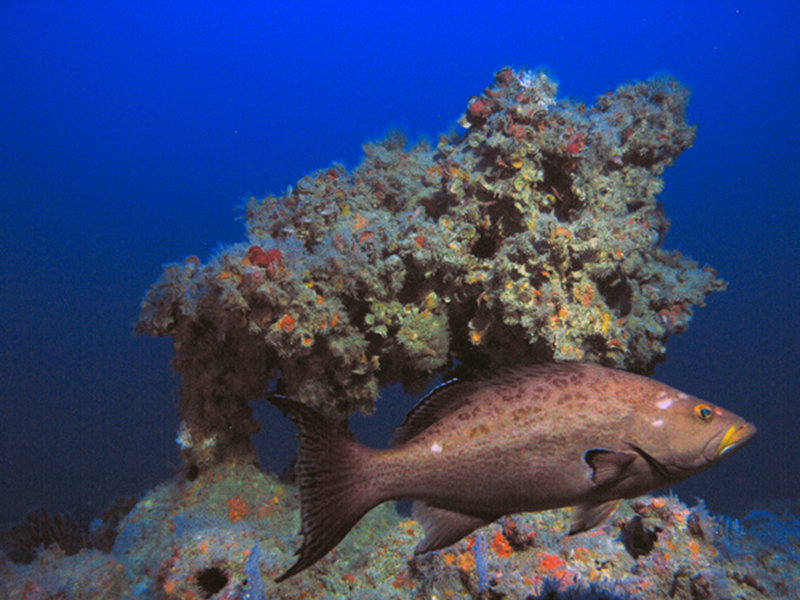
Robert Cowen, Ph.D., Director and Project Lead - Hatfield Marine Science Center, Oregon State University
August 13-29, 2013

Deep reefs, referred to as mesophotic coral ecosystems, can be found from 100-330 feet in the eastern Gulf of Mexico. Pictured is a scamp grouper at 320 feet off the Dry Tortugas. Image courtesy of Cooperative Institute for Exploration, Research & Technology. Download image (130 KB).
The Coral Ecosystem Connectivity 2013 expedition from Pulley Ridge to the Florida Keys is funded by NOAA’s National Centers for Coastal Ocean Science and Office of Ocean Exploration and Research in partnership with NOAA’s Office of National Marine Sanctuaries, National Marine Fisheries Service’s Southeast Regional Office, and Gulf of Mexico Regional Collaboration Team. The project is led by the University of Miami, and represents a collaboration of over 35 scientists at eleven different universities pooling their expertise with state and federal agency scientists through NOAA’s Cooperative Institute for Marine and Atmospheric Studies at the University of Miami in coordination with the Cooperative Institute for Ocean Exploration, Research, and Technology at Florida Atlantic University.
The project is focused on investigating the role that the relatively healthy deep, mesophotic reefs of Pulley Ridge (off the southwest coast of Florida) may play in replenishing key fish species, such as grouper and snapper, and other organisms in the downstream reefs of the Florida Keys and Dry Tortugas. Because of the well-documented decline of Florida’s reefs, it is important to identify, protect, and manage sources of larval reef species that can help sustain Florida’s reef ecosystems and the tourism economy that depends on it.
A unique aspect of our project is a Stakeholder Advisory Board, a collaboration of federal, state, and nongovernmental stakeholders, to help guide outputs and ensure their utility for resource managers. The goal of this study is to not only provide a better understanding of the underlying processes that regulate Pulley Ridge and whether Pulley Ridge helps sustain the coral reef communities in the Florida Keys and Dry Tortugas, but also to help determine if the area would benefit from further protection.
The coral reef ecosystems of the southeast United States provide habitat, food, and shelter to hundreds of species of fish and invertebrates. Their economic role in supporting commercial fisheries, tourism, and recreational industries is also considerable. In addition to their aesthetic value, coral reefs provide structural buffers from storms and currents along the highly populated southeast Florida coast. Observations of relatively healthy mesophotic reefs on Pulley Ridge have opened up questions as to the ecological role they may play in the replenishment of shallow and other mesophotic coral ecosystems, such as in the Florida Keys and Dry Tortugas. In an era of rapid coastal ocean changes, it is important to understand the degree of connectivity between Pulley Ridge, a comparatively healthy coral ecosystem, and other coral ecosystems located downstream.
NOAA National Centers for Coastal Ocean Science
University of Miami
Florida Atlantic University
California Academy of Sciences
City University of New York
Florida International University
Florida Fish and Wildlife Conservation Commission
Florida State University
NOAA Atlantic Oceanographic and Meteorological Laboratory
NOAA Fisheries’ Southeast Fisheries Science Center
Nova Southeastern University
Oregon State University
University of British Columbia
University of Florida
University of North Carolina, Wilmington
Bureau of Ocean Energy Management
Everglades and Dry Tortugas National Parks
Florida Fish and Wildlife Research Institute
Gulf Coast Ecosystem Restoration Task Force
Gulf of Mexico Fishery Management Council
The Nature Conservancy
NOAA Fisheries’ Southeast Fisheries Science Center
NOAA Fisheries’ Southeast Regional Office
NOAA Office of National Marine Sanctuaries
NOAA Office of Ocean Exploration and Research
South Atlantic Fishery Management Council
The essays below will help you to understand the goals and objectives of the mission and provide additional context and information about the places being explored and the science, tools, and technologies being used.
R/V F.G. Walton Smith: August 13-27, 2013 - M/V Spree: August 19-29, 2013 | By Robert Cowen, Ph.D.
This is the second year of a five year study to investigate the role that the mesophotic reefs of Pulley Ridge (off the southwest coast of Florida) may play in replenishing key fish species, such as grouper and snapper, and other organisms in the downstream reefs of the Florida Keys and Dry Tortugas.
Read moreBy Robert Cowen, Ph.D.
Understanding the factors that determine where mesophotic reefs are located, and distances over which species living within such environments disperse and therefore ‘connect’ populations are of great interest to marine scientists and resource managers alike.
Read moreBy Kimberly Puglise
The term “coral” conjures up visions of warm, tropical waters, or, as of late, the cold dark depths of the ocean where not a ray of sunlight penetrates. Found between these two visions is a relatively unknown and poorly understood depth realm referred to as the mesophotic zone – ‘meso’ for middle and ‘photic’ for light.
Read moreBy Stephanie Farrington and John Reed
Pulley Ridge is the deepest known photosynthetic coral reef off the continental U.S. Located in the Gulf of Mexico; it lies approximately 66 km west of the Dry Tortugas at the far end of the Florida Keys. Originally discovered in 1950, Pulley Ridge is approximately 300 km in length and 15 km wide.
Read moreBy Sean Morton and Beth Dieveney
The waters of the Florida Keys boast spectacular coral reefs. Much of this reef ecosystem, which plays an integral role in the tourism-based economy of the Keys, is protected by the Florida Keys National Marine Sanctuary.
Read more